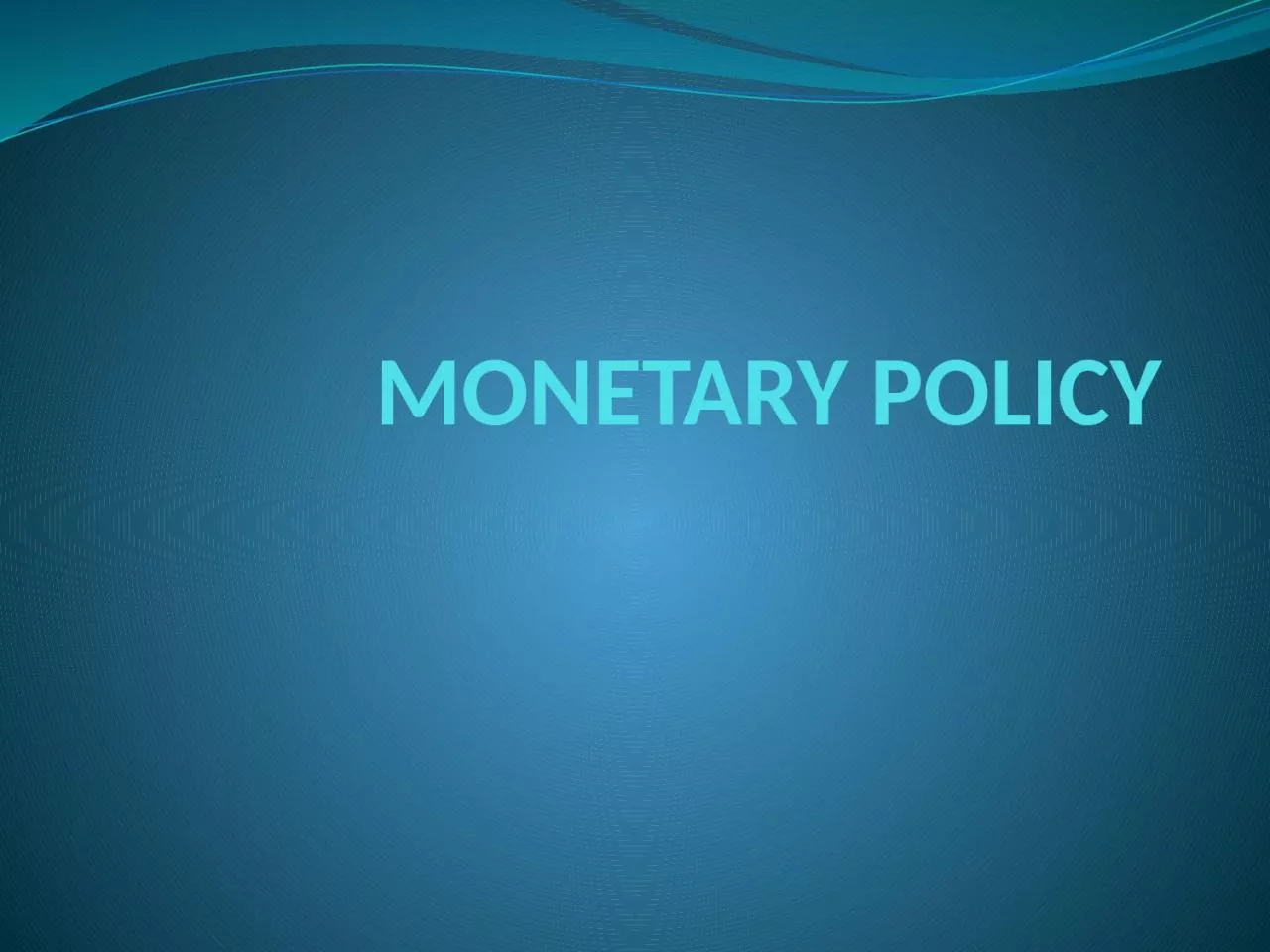

Introduction Monetary policy is concerned with the changes in the supply of money and credit It refers to the policy measures undertaken by the government or the central bank to influence the availability cost and use of money and credit with the help of monetary techniques to achieve specifi ID: 1029605
Download Presentation The PPT/PDF document "MONETARY POLICY MEANING OF MONETARY POLI..." is the property of its rightful owner. Permission is granted to download and print the materials on this web site for personal, non-commercial use only, and to display it on your personal computer provided you do not modify the materials and that you retain all copyright notices contained in the materials. By downloading content from our website, you accept the terms of this agreement.
1. MONETARY POLICY
2. MEANING OF MONETARY POLICY Introduction- Monetary policy is concerned with the changes in the supply of money and credit. It refers to the policy measures undertaken by the government or the central bank to influence the availability, cost and use of money and credit with the help of monetary techniques to achieve specific objectives. It aims to influence two major variables: 1. Money or Credit Supply 2. The rate of interest.
3. DEFINITIONS“the management of the expansion and contraction of the volume of money in circulation for the explicit purpose of attaining a specific objectives such as full employment,” by R.P. KentAccording to Shapiro, “ Monetary Policy is the exercise of the central bank’s control over the money supply as an instrument for achieving the objectives of economic policy.”
4. OBJECTIVESVarious objectives or goals of monetary policy are:Neutrality of moneyExchange stabilityPrice stabilityFull EmploymentEconomic growth
5. INSTRUMENTS OF MONETARY POLICY The monetary authority can influence the level of aggregate demand for the purpose of achieving specific economic objectives through three prime levers: 1. Supply of Money 2. Cost of Money 3. Availability of Credit The instruments of monetary policy are the devices through which supply and cost of money and availability of credit can be affected in Qualitative or Quantitative terms.
6. QUANTITATIVE AND QUALITATIVE INSTRUMENTSBank rateOpen Market OperationsVariations in Reserve RequirementsCeiling on AdvancesAdvances DirectivesMoral suasionConsumer Credit Regulations These instruments influence upon supply, cost and availability of money which ultimately shape the pattern of variations in the level of aggregate demand and the general level of economic activity.
7. ROLE OF MONETARY POLICY IN DEVELOPING COUNTRIESDeveloping versus Developed Economies- The monetary policy in a developing economy will have to be quite different from that of a developed economy mainly due to different economic conditions and requirements of the two types of economies. A developed economy may adopt full employment or price stability or exchange stability as a goal of the monetary policy. But in developing economy economic growth is the primary and basic necessity. Thus, in a developing economy the monetary policy should aim at promoting economic growth.
8. ROLE OF MONETARY POLICY IN DEVELOPING COUNTRIES….contd. Monetary Policy can serve the following developmental requirements of developing economies:Developmental RoleCreation and Expansion of financial InstitutionsEffective Central BankingIntegration of Organised and Unorganized Money MarketDeveloping Banking HabitsMonetisation of Economy
9. ROLE OF MONETARY POLICY IN DEVELOPING COUNTRIES….contd.Integrated Interest Rate StructureDebt ManagementMaintaining Equilibrium in Balance of PaymentsControlling Inflationary PressuresLong Term Loans for Industrial DevelopmentReforming Rural Credit System
10. LIMITATIONS AND PROBLEMS OF MONETARY POLICY LIMITATIONS- Monetary policy has been defined as a policy of the central bank to control the money supply for achieving the objectives of general economic policy. This implies that the problem of monetary policy is the determination of the optimal quantity of money, or in dynamic conditions, the optimal rate of growth of the money stock. But in actual practice, it is difficult not only to define but also to determine the optimal money stock.
11. LIMITATIONS AND PROBLEMS OF MONETARY POLICY……..contd. So in real world monetary policy faces a number of problems which reduces its scope and effectiveness, which are-Conflicting GoalsLags in Monetary Policy: 1. Recognition Time Lag 2. Action Time Lag 3. Inside Time Lag 4. Outside Time LagChanges in Velocity of Money:Velocity of money can vary in number of ways-----Development of NBFIs
12. LIMITATIONS AND PROBLEMS OF MONETARY POLICY……..contd.Portfolio Adjustment of Commercial BanksIntensive Use of Available Money SupplyTarget ProblemIndicator Problem
13. EFFECTIVENESS OF MONETARY POLICY IN BOOM AND INFLATIONIn Boom: The basic problem during boom time is one of an overly expansion of aggregate demand. An anti-inflationary policy stressed upon reduced money supply and increased interest rate structure. A combination of tight money and credit measures may keep the system in equilibrium at full employment without inflation. We can follow the following measures to control the supply of money:1. Changes in the velocity of money
14. EFFECTIVENESS OF MONETARY POLICY IN BOOM AND INFLATION…….contd.2. Commercial bank portfolio adjustment3. Growth of NBFIs4. Evolution of methods of more effective use of available funds5. Risk destabilisation6. Debt management operations7. Discriminatory Effect8. Uncertainty concerning appropriate monetary policy.
15. THE END